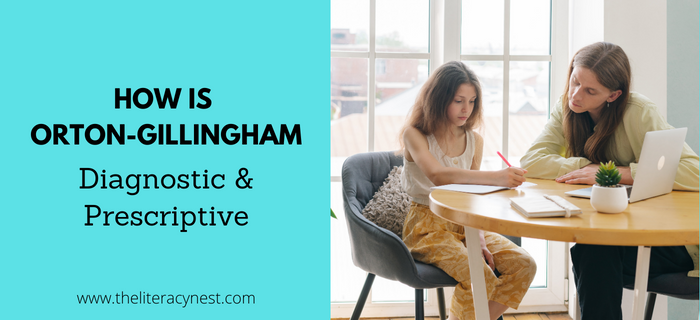5 Creative Orton-Gillingham Lesson Warm-Up Ideas!

An Orton-Gillingham lesson warm-up is a brief activity at the beginning of a lesson to get the student ready for learning. It should be quick, less than 5 minutes, and targeted. This may provide additional practice in an area that they are still having difficulty with, an area that you don’t have a lot of time to address during the lesson, or simply prime the pump and get the brain awake and ready to go.
For older students, this may take a few minutes to ask them about how they are doing or how their day is going. Sometimes they are carrying a lot of baggage from their school day and taking a moment to share something may be just what they need to be ready to learn.

Here are Five Creative Ideas You Can Use to Warm-Up in Your Orton-Gillingham Lessons
1. Alphabet Sequencing
As teachers, we often take for granted that students with some reading and writing skills know the alphabet very well. It can be surprising to discover that even some older students may not be automatic and flexible with this knowledge. There are a couple of ways we can address this during a warm-up.
- The alphabet arc: Asking students to match or fill in some or all of the letters on an alphabet arc. This can be adjusted to be more challenging by having a blank alphabet arc, or easier by having students match letters. They can match uppercase images and lowercase foam letters.
- Alphabet sequence strip: If the entire alphabet arc is too overwhelming for your student, you might instead pull out a section of the alphabet, 9 letters is a good length and leave 3 of the letters blank. Students can say the alphabet up to the starting point of the strip, place letters, or write letters in the blanks, and then complete the rest of the alphabet orally. This reinforces alphabetical order, letter recognition, and recall.
- Manipulatives: For children earlier in their learning journey, you might use manipulatives for just some recently introduced letters and have them match uppercase and lowercase pairs for example. This is a great place to utilize the types of hands-on materials you might typically find in classroom centers. It can also build in fine motor skills practice with activities such as Alphabet Alligators, Alphabet puzzles, or using little tweezers to find certain letters and practice their pincer grasp.
- Writing alphabet: For older children, having them write the alphabet in order allows them to become more fluent and flexible with their alphabetic knowledge. As a teacher, you can observe areas of difficulty or confusion that might be targeted with alphabet strips or specific instruction.
2. Letter Reversals
Few things remain as consistently troublesome for students with dyslexia as letter reversals. Warm-ups are a great time to give extra targeted practice in this area. The activities are only limited by your imagination, but here are some possibilities.
Looking for ideas to Shake Up Your Visual Card Drill? Read this blog post and join our Beyond the Card Drill Challenge!
- Review verbal pathways and visuals for assisting with b and d. Have students practice using the tool during this time so that it is available to them when they need it.
- Trace sandpaper letters while reciting verbal pathways.
- Read a paper strip of b’s and d’s. This is a great opportunity to prompt students to use their visual tool, such as a reference card or their b hand.
- Write or trace a paper strip of b’s and d’s. Again using the language for verbal pathways will reinforce proper letter formation.
- Other letter reversal activities: letter mazes, crossing off certain letters, or filling in the missing letter in common words.
3. Handwriting
While you are likely to spend more time later in the lesson on handwriting, the warmup is a great opportunity to give it a little extra attention. Introducing a new cursive letter or stroke., practicing letter placement on the lines, and reinforcing letter formation using verbal pathways can fit powerfully into the warm-up section of the lesson.
4. Spot It
Spot It is an example of a strategic game choice that helps build students’ skills at noticing differences and working memory. It is also a favorite with children. Interestingly, I have found that some of the students with the most significant attention difficulties tend to be excellent at this game. Many of our students have an ADHD diagnosis in addition to dyslexia. This game helps them to practice directing their attention to specific things.
5. Dates or Months of the Year
Our students often have surprising gaps in their knowledge. There are skills they need to know that we may take for granted. This may include the days of the week, months of the year, or how to write the date. This can be practiced very quickly by talking about the day, month, and date and how to write it. This will help students when the time comes to set up their papers for dictation practice.
Ready to dig deeper into this topic? Watch my YouTube video: Warm-Up Ideas for Orton-Gillingham Lessons!
With a cache of Orton-Gillingham lesson warm-up ideas and thoughtful decision-making, you can make every second count and get the most possible learning accomplished during your OG lesson.
Are you looking for professional development that will help you better support your students with dyslexia? The Literacy Nest has a membership for that…
Building Readers for Life Academy is a monthly membership program that empowers educators AND families. It dives into structured literacy and strategies for ALL learners. With BRFL Academy, you’ll learn what it takes to help EVERY student become a reader for life.
Join Building Readers for Life Academy today and pay just $1 for your first 30 days! Click here.







